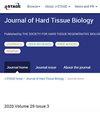Establishment and Characterization of the Human Tongue Squamous Cell Carcinoma Cell Line NOKT-1
IF 0.4
4区 医学
Q4 ENGINEERING, BIOMEDICAL
引用次数: 2
Abstract
The squamous cell carcinoma cell line NOKT-1 was successfully established from the right tongue of a 74-yearold Japanese man. Pathological diagnosis of the original tumor was moderately differentiated squamous cell carcinoma. NOKT-1 cells were transplanted subcutaneously into nude mice and xenograft was formed. In addition, the NOKT-1-XG cell line was established from the transplanted tumor of NOKT-1 cells. NOKT-1 cells and NOKT-1-XG cells were epithelial neoplastic and pleomorphic cells, which were similar. Immunocytochemistry revealed that NOKT-1 and NOKT-1-XG cells were CK17 and human mitochondria positive. To authenticate the NOKT-1 cell line and NOKT-1-XG cell line, we examined cross-contamination with other cell lines using short tandem repeat analysis, the results of which showed that NOKT-1 and NOKT-1-XG are new cell lines. Four of the 16 loci, corresponding to 25%, were different between these two cell lines, which indicates that the NOKT-1 genome was altered by transplantation. Moreover, in AM, NOKT-1 did not have a Y chromosome, whereas NOKT-1-XG had. Despite the genetic differences, a collagen gel droplet-embedded culture drug susceptibility test demonstrated that NOKT-1 cells derived from the original tumor and the NOKT-1-XG cell line had the same sensitivity. This cell line could be very useful for the development of immunotherapy and chemotherapy regimens and research on cancer etiology.人舌鳞状细胞癌NOKT-1细胞系的建立与鉴定
从一名74岁的日本男性右舌成功建立了鳞状细胞癌细胞系NOKT-1。原发肿瘤病理诊断为中分化鳞状细胞癌。裸鼠皮下移植NOKT-1细胞,形成异种移植物。此外,从NOKT-1细胞的移植瘤中建立了NOKT-1- xg细胞系。NOKT-1细胞和NOKT-1- xg细胞是上皮性肿瘤细胞和多形性细胞,两者相似。免疫细胞化学显示NOKT-1和NOKT-1- xg细胞CK17和人线粒体阳性。为了鉴定NOKT-1细胞系和NOKT-1- xg细胞系,我们使用短串联重复分析检查了与其他细胞系的交叉污染,结果表明NOKT-1和NOKT-1- xg是新细胞系。16个基因座中有4个(25%)在这两个细胞系之间存在差异,这表明移植改变了NOKT-1基因组。此外,在AM中,NOKT-1没有Y染色体,而NOKT-1- xg有。尽管存在遗传差异,但胶原凝胶滴包埋培养药敏试验表明,来自原始肿瘤的NOKT-1细胞与NOKT-1- xg细胞系具有相同的敏感性。该细胞系对免疫治疗和化疗方案的开发以及癌症病因学的研究非常有用。
本文章由计算机程序翻译,如有差异,请以英文原文为准。
求助全文
约1分钟内获得全文
求助全文
来源期刊

Journal of Hard Tissue Biology
ENGINEERING, BIOMEDICAL-
CiteScore
0.90
自引率
0.00%
发文量
28
审稿时长
6-12 weeks
期刊介绍:
Information not localized
 求助内容:
求助内容: 应助结果提醒方式:
应助结果提醒方式:


